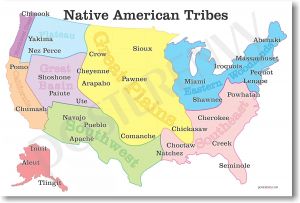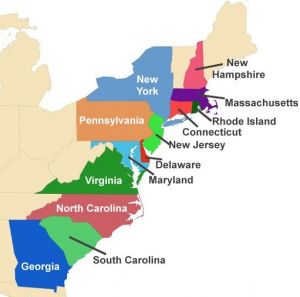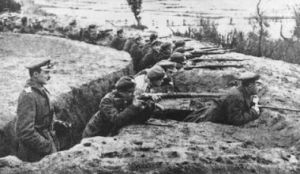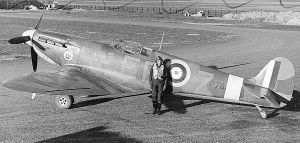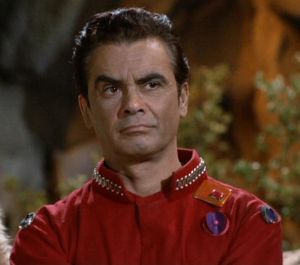United States of America
The country known as the United States of America was founded in 1776, and was a part of the continent of "North America."
It shared significant land borders with Canada to the north, Mexico to the south, and limited maritime borders with the Bahamas, Cuba, and Russia.
Contents
North America
Original Inhabitants
The first people of North America migrated from Siberia, by way of the Bering land bridge, arriving at least 12,000 years prior to the forming of the United States (if not earlier).
The Clovis culture, which appeared around 11,000 BC, is believed to represent the first wave of human settlement of the Americas. This was likely the first of three major waves of migration into North America.
- Over time, indigenous cultures in North America grew increasingly complex, developing advanced agriculture, architecture, and societies.
- Most prominent along the Atlantic coast were the Algonquian tribes, who practiced hunting and trapping, along with limited cultivation.
- Populations were believed to be around 1.1 million along the shores of the Gulf of Mexico, 2.2 million people living between Florida and Massachusetts,
5.2 million in the Mississippi Valley and tributaries, and around 700,000 people in the Florida peninsula.
European Invasion
Claims of early colonization of coastal New England by the Norse are disputed and controversial. The first documented arrival of Europeans in the continental United States is of Spanish conquistadors. Even earlier, Christopher Columbus had landed in Puerto Rico on his 1493 voyage. The Spanish set up the first settlements in Florida and New Mexico. The French established their own settlements along the Mississippi River, notably New Orleans. Successful English settlement of the eastern coast of North America began in 1607. In 1784, the Russians were the first Europeans to establish a settlement in Alaska, at Three Saints Bay. Many settlers on the "mainland" (the Europeans) were dissenting Christians who came seeking religious freedom.
- In the early days of colonization, many European settlers were subject to food shortages, disease, and attacks from Native Americans.
- Over time, the two people began trading, and the settlers were taught how to cultivate corn, beans, and other foodstuffs. Not completely grateful, European missionaries and others felt it was important to "civilize" the Native Americans, and urged them to adopt European agricultural practices and lifestyles. However, with the increased European colonization of North America, the Native Americans were displaced and often killed. The native population of America declined after European arrival, primarily due to diseases such as smallpox and measles.
These United States
Infancy
The European colonies came together, and signed the Declaration of Independence in 1776. The day of signing was celebrated annually as "Independence Day."
Irreconcilable sectional conflict regarding the enslavement of Africans and African Americans ultimately led to the American Civil War in 1861, lasting to 1865. The President of the time issued a decree to end slavery in the country, and the side (Union) against slavery defeated the side for slavery (Confederacy) in 1865. Reconstruction of the nation began immediately following the war, but was halted with the assassination of the President who had been against slavery, making it clear that the southern states (also known as the Confederate States) were still furious.
Southern white Democrats, calling themselves "Redeemers", took control of the South after the end of Reconstruction, beginning the nadir of American race relations. From 1890 to 1910, the states established "Jim Crow laws," disenfranchising most people of black and brown heritage, as well as some money-poor whites throughout the region. People with black and brown skin faced segregation nationwide, especially in the South. They also occasionally experienced "vigilante violence," including lynching.
In the western part of the nation, nation-wide infrastructure, including the wide use of the telegraph, and the building and use of trans-continental railroads, spurred economic growth and greater settlement and development of what was to be known as the "American Old West." Later, the invention of the electric light, and the telephone would also affect communication and urban life.
World Wars
The United States remained neutral in the first world-wide war until 1917, joining alongside the Allies, helping to turn the tide against the Central Powers.
- War opened the passageways for technology, and the 1920s and 1930s saw the rise of radio for mass communication, as well as the invention of early television.
The United States remained "officially" neutral during the planet's second world war, though they supplied the Allies with whatever they could. Once attacked on their homeland, they openly joined on the side of the Allied Powers.
- The United States was one of the four countries who met to plan the postwar world, along with Britain, the Soviet Union, and China.
After the second world-wide war, the United States and the Soviet Union (Russia) competed for dominate power, influence, and prestige, a time that became known as the Cold War.
- While the U.S. and Soviet Union engaged in proxy wars and developed powerful nuclear arsenals, the two countries avoided direct military conflict.
- The Soviet Union's 1957 launch of the first artificial satellite, and its 1961 launch of the first crewed spaceflight, initiated a "Space Race" in which the United States became the first nation to land a man on Earth's moon in 1969.
- The Cold War was ended in 1991 when the Soviet Union was dissolved.
The Eugenics Wars, in an effort to improve humans via biology, were fought between 1992 and 1996. These wars devastated parts of Earth, by some estimates causing around thirty million deaths. Scientists created enhanced humans known as Augments during the Cold War, in the hopes that they would lead Humanity into an era of peace.
- Many Augments took control of world powers, believing themselves to be better than ordinary humans. Overthrown in 1996, the remaining Augment embryos were collected and placed into storage.
- As a result of the Eugenics wars, genetic engineering was banned on Earth.
The third world-wide war on Earth was the last of the planet's world-wide conflicts. Involving nuclear cataclysm, as well as genocide and eco-terrorism, the post-atomic horror superseding the war lingered as late as 2079. With the threat of eugenics still lingering, this war resulted in the death of some six hundred million Humans. By the end, most of the major cities had been destroyed, and there were few governments left.
- The United States suffered numerous devastating attacks at the hands of the Eastern Coalition (also referred to as "the ECON").
- The war ended with a cease fire, and Earth's atmosphere continued to contain radioactive isotopes, indicative of the conflict over a decade later.
First Contact
In 2063, Vulcans made first contact in the United States' area of Montana.
In 2153, the Xindi attacked Earth, including devastating the area known as Florida in the United States.
In 2150, the United States of America joined the United Earth Government, which later became the United Federation of Planets in 2161.
